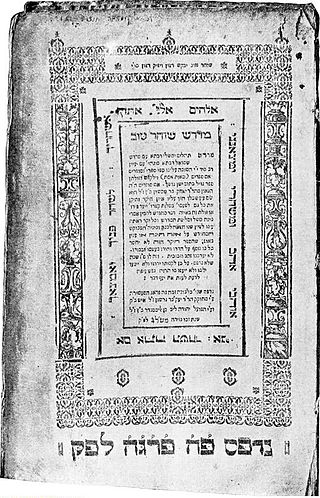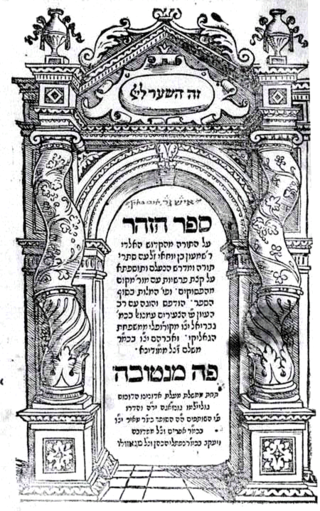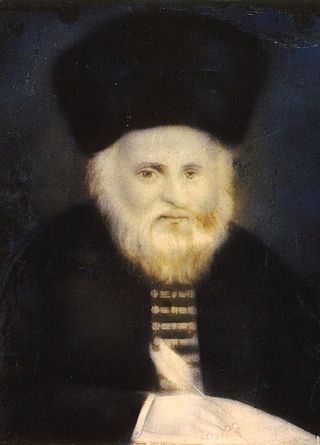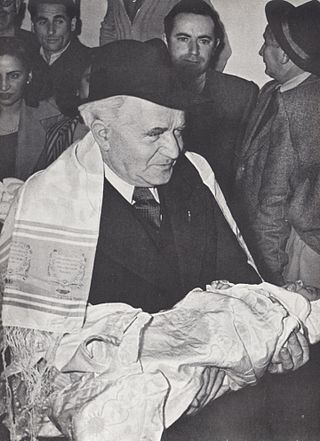Related Research Articles

Midrash is expansive Jewish Biblical exegesis using a rabbinic mode of interpretation prominent in the Talmud. The word itself means "textual interpretation", "study", or "exegesis", derived from the root verb darash (דָּרַשׁ), which means "resort to, seek, seek with care, enquire, require", forms of which appear frequently in the Hebrew Bible.

The Zohar is a foundational work of Kabbalistic literature. It is a group of books including commentary on the mystical aspects of the Torah and scriptural interpretations as well as material on mysticism, mythical cosmogony, and mystical psychology. The Zohar contains discussions of the nature of God, the origin and structure of the universe, the nature of souls, redemption, the relationship of Ego to Darkness and "true self" to "The Light of God".

Rabbinic literature, in its broadest sense, is the entire spectrum of rabbinic writings throughout Jewish history. However, the term often refers specifically to literature from the Talmudic era, as opposed to medieval and modern rabbinic writings, and thus corresponds with the Hebrew term Sifrut Chazal. This more specific sense of "Rabbinic literature"—referring to the Talmudim, Midrashim, and related writings, but hardly ever to later texts—is how the term is generally intended when used in contemporary academic writing. The terms mefareshim and parshanim (commentaries/commentators) almost always refer to later, post-Talmudic writers of rabbinic glosses on Biblical and Talmudic texts.

Elijah ben Solomon Zalman,, also known as the Vilna Gaon (Yiddish: דער װילנער גאון Der Vilner Goen; Polish: Gaon z Wilna, Gaon Wileński; { or Elijah of Vilna, or by his Hebrew acronym Gra, was a Lithuanian Jewish Talmudist, halakhist, kabbalist, and the foremost leader of misnagdic Jewry of the past few centuries. He is commonly referred to in Hebrew as ha-Gaon mi-Vilna, "the genius from Vilnius".

Aggadah is the non-legalistic exegesis which appears in the classical rabbinic literature of Judaism, particularly the Talmud and Midrash. In general, Aggadah is a compendium of rabbinic texts that incorporates folklore, historical anecdotes, moral exhortations, and practical advice in various spheres, from business to medicine.

SalomonBuber was a Jewish Galician scholar and editor of Hebrew works. He is especially remembered for his editions of Midrash and other medieval Jewish manuscripts, and for the pioneering research surrounding those texts.
Tobiah ben Eliezer was a Talmudist and poet of the 11th century, author of Lekach Tov or Pesikta Zutarta, a midrashic commentary on the Pentateuch and the Five Megillot.

Sifre refers to either of two works of Midrash halakha, or classical Jewish legal biblical exegesis, based on the biblical books of Numbers and Deuteronomy.

A sandek or sandak is a person honored at a Jewish brit milah (circumcision) ceremony, traditionally either by holding the baby boy on the knees or thighs while the mohel performs the brit milah, or by handing the baby to the mohel.
Enoch Zundel ben Joseph was a Polish Talmudist best known as author of three commentaries on Ein Yaakov, He authored the books "Etz Yosef", "Anaf Yosef", and "Yad Yosef". He also wrote commentaries on Midrash Rabbah, Midrash Tanchuma and others. He spent his life in Białystok, Poland; he was a maggid there and gave shiurim on Midrash.
In Jewish eschatology Mashiach ben Yoseph or Messiah ben Joseph, also known as Mashiach bar/ben Ephraim, is a Jewish messiah from the tribe of Ephraim and a descendant of Joseph. The figure's origins are much debated. Some regard it as a rabbinic invention, but others defend the view that its origins are in the Torah.

The Mekhilta of Rabbi Shimon ben Yochai is midrash halakha on Book of Exodus from the school of Rabbi Akiva attributed to Shimon bar Yochai. No midrash of this name is mentioned in Talmudic literature, but Nachmanides (d.1270) refers to one which he calls either Mekhilta de-Rabbi Shimon ben Yochai, Mekhilta Achǝrita de-Rabbi Shimon, or simply Mekhilta Acheret. Todros ben Joseph Abulafia (d.1285) also refers to Mekhilta de-Rabbi Shimon ben Yochai.

Midrash HaGadol or The Great Midrash is a work of aggaddic midrash, expanding on the narratives of the Torah, which was written by David ben Amram Adani of Yemen.

A number of midrashim exist which are smaller in size, and generally later in date, than those dealt with in the articles Midrash Haggadah and Midrash Halakah. Despite their late date, some of these works preserve material from the Apocrypha and Philo of Alexandria. These small works, were in turn used by later larger works, such as Sefer haYashar (midrash). Important editors and researchers of this material include Abraham ben Elijah of Vilna, Adolf Jellinek, and Solomon Aaron Wertheimer.

Baraita on the Erection of the Tabernacle is a baraita cited several times by Hai ben Sherira, by Nathan ben Jehiel in the Arukh, as well as in Rashi, Yalkut Shimoni, and Maimonides. Rashi calls it a "Mishnah".

Midrash Maaseh Torah is one of the smaller midrashim, and contains compilations of doctrines, regulations of conduct, and empirical rules, arranged in groups of three to ten each and taken from various works. It is frequently found in manuscript, and has been edited at Constantinople (1519), Venice (1544), Amsterdam (1697), and elsewhere, while it has appeared more recently in A. Jellinek's B. H. and is contained also in the Kol Bo, where it frequently deviates from the Amsterdam edition even in the arrangement of its sentences.
Aaron Walden was a Polish Jewish Talmudist, editor, and author.

Mattityahu Strashun was a Lithuanian Talmudist, Midrashic scholar, book collector, communal leader, and philanthropist. He amassed a significant private collection of books and rare manuscripts which formed the basis for the Strashun Library of Vilnius, which operated from 1892 to 1941.
Lailah is an angel in some interpretations in the Talmud and in some later Jewish mythology, associated with the night, as well as conception and pregnancy.
Aaron Jekel ben Samuel Schor of Frankfurt also known as the Beis Aharon of Frankfurt was a 17th-century Jewish-German rabbi and Hebrew author, best known for his work "Beis Aharon", which is considered to be amongst the most important concordances of the Bible.
References
- ↑ I Idelson-Shein, "Their Eyes Shall Behold Strange Things": Abraham Ben Elijah of Vilna Encounters the Spirit of Mr. Buffon," AJS Review, Vol. 36, Issue 2 (2012), pp. 295-322
 This article incorporates text from a publication now in the public domain: Singer, Isidore; et al., eds. (1901–1906). "Abraham ben Elijah of Wilna". The Jewish Encyclopedia . New York: Funk & Wagnalls.
This article incorporates text from a publication now in the public domain: Singer, Isidore; et al., eds. (1901–1906). "Abraham ben Elijah of Wilna". The Jewish Encyclopedia . New York: Funk & Wagnalls.- Cowley, Arthur Ernest (1911). . In Chisholm, Hugh (ed.). Encyclopædia Britannica . Vol. 13 (11th ed.). Cambridge University Press. p. 176.